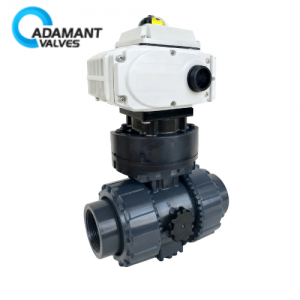Buying Guide: Understanding the Types of Sanitary Ball Valves

Clamp-type, weld-type, three-piece, full bore… There are various types and choices for sanitary ball valves. So, what are the characteristics of each type, and what other types of sanitary ball valves are available besides these?
Classification by Connection Type
The connection type is the primary dimension when selecting a sanitary ball valve. It directly relates to installation convenience, sealing effectiveness, and cleaning method.
What are the End Connection Types for Valves?
Clamp-Type Sanitary Ball Valve
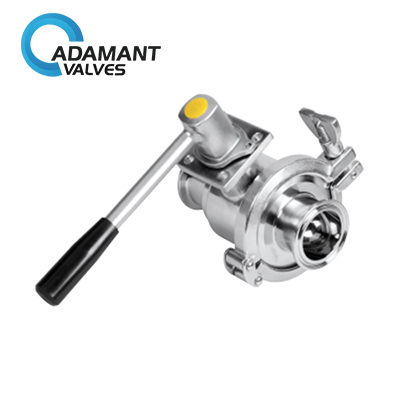
AV-2-S0440 Middle Clamp Non-Retention Ball Valve
This valve uses internationally standard Tri-Clamp fittings and food-grade sealing rings for connection. Its greatest advantage is extremely easy installation and disassembly. It can be quickly disassembled and thoroughly cleaned without special tools. This perfectly meets the needs of processes requiring frequent CIP (Cleaning-in-Place). Consequently, the clamp-type sanitary ball valve is also the most widely used type in sanitary applications.
Weld-Type Sanitary Ball Valve
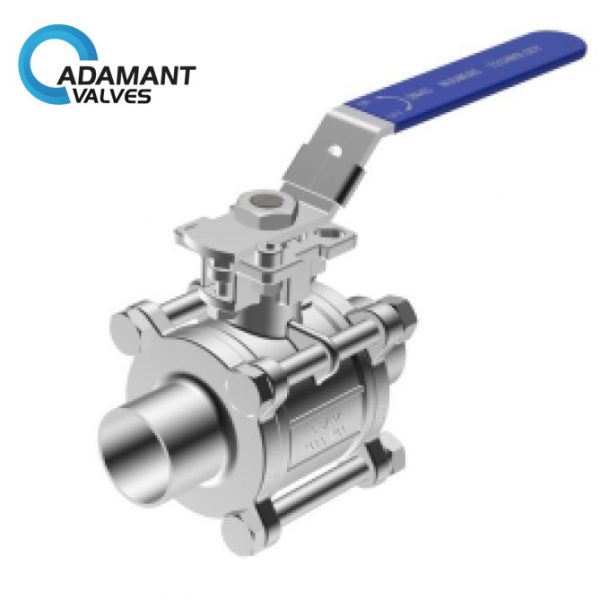
AV-2PW Sanitary Titanium 3 Piece Welded Ball Valve
As the name implies, this type of valve is connected to the pipeline via welding. This means it achieves zero dead space at the connection point. Simultaneously, it offers the most excellent sealing performance and structural strength among all connection methods. It can be said to fundamentally eliminate the risk of leakage. On the other hand, because it’s a permanent connection, if the valve needs maintenance or replacement, the entire pipe section must be cut out, making the operation very inconvenient.
It is mainly used in systems with extreme purity requirements, such as purified water and Water for Injection (WFI) pipelines in the pharmaceutical industry, and high-purity bioprocessing systems.
Flanged Sanitary Ball Valve

AV-2TF Sanitary Titanium Flanged Ball Valve
Flanged valves are connected via matching flanges and bolts. This structure is very robust and can withstand high pipeline stress. Disassembly convenience is not as good as the clamp type, and it is relatively bulky. Nevertheless, it remains a reliable and common choice for large-diameter pipelines or certain applications requiring higher pressure tolerance.
Classification by Valve Body Structure
The valve body structure determines the valve’s maintainability, durability, and cost-effectiveness.
One-Piece Sanitary Ball Valve
The one-piece sanitary ball valve has the simplest structure, with its body being an inseparable single unit. This design is compact, lightweight, and has the lowest manufacturing cost. However, its significant drawback stems from this: once the internal ball or sealing seats wear out or get damaged, repair is extremely difficult. The usual course of action is to scrap and replace the whole valve. As a result, one-piece ball valves are typically used in non-critical pipelines with limited space, minimal maintenance requirements, and a very tight budget.
Two-Piece Sanitary Ball Valve
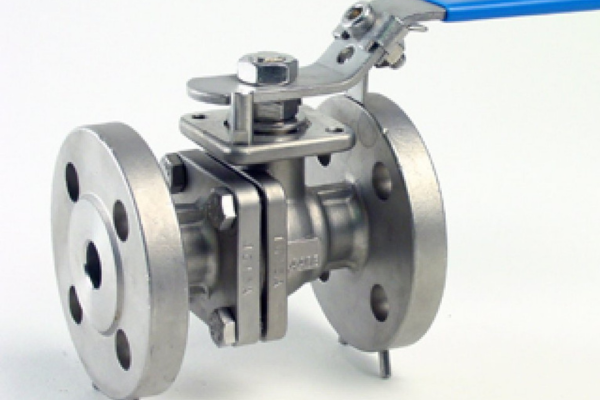
As the name suggests, the body of a two-piece ball valve consists of two main parts, typically bolted together. It derives its most apparent benefit from its ease of maintenance. When the internal ball or seals need to be replaced, maintenance personnel do not have to remove the entire valve from the pipeline. Simply loosening the connecting bolts allows one half of the body to be opened for servicing. This fundamentally saves time and long-term maintenance costs.
Three-Piece Sanitary Ball Valve
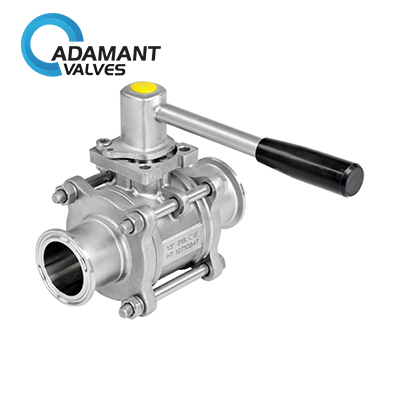
AV-2-S0439 Three-Piece Ball Valve
A three-piece valve has a body consisting of three parts: a center section, two end caps, joined together by long through-bolts. This allows easier and more thorough maintenance compared to the two-piece variety. Both end caps can be removed freely, which makes for thorough cleaning and inspection of the interior of the valve. In addition, the center body section is sometimes rotatable by 360°, allowing greater flexibility in pipeline layout.
Classification by Bore Size
The bore type affects fluid pressure loss and the presence of stagnant zones.
Full Bore Sanitary Ball Valve
The bore diameter of a full bore ball valve is essentially the same as the inner diameter of the connecting pipeline. This design results in minimal fluid resistance and negligible pressure drop. It also effectively prevents media stagnation within the valve cavity and supports CIP cleaning of the ball. It is particularly suitable for conveying viscous liquids, slurries, or critical process lines requiring stable pressure.
Reduced Bore Sanitary Ball Valve
The ball bore diameter of a reduced bore ball valve is significantly smaller than the diameter of its connecting pipeline. This design makes the valve more compact and lower in cost. The trade-off is higher fluid resistance and the creation of stagnant zones inside the valve body, which may hinder thorough cleaning. Therefore, it is often used for non-critical auxiliary lines where flow rate and pressure loss are not major concerns.
Classification by Ball Bore Shape
O-Port Ball Valve
The ball bore in an O-port ball valve is a standard circular through-hole. It is the most common and basic type of ball valve. Its name comes from the complete circular “O” shaped bore through the ball. When the valve is open, it forms a straight, circular flow path essentially matching the pipe’s inner diameter. Thus, its function is purely for “fully open” or “fully closed” control of the fluid.
V-Port Ball Valve
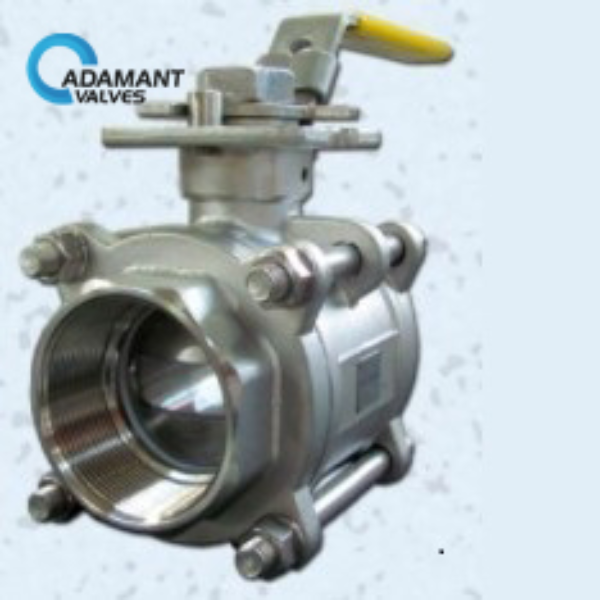
AV-2SV Stainless Steel V-Port Ball Valve
A V-port ball valve does not have a full circular bore but rather a V-shaped notch or segment. Unlike the simple on/off function of an O-port valve, it can control flow rate. As the valve rotates, the flow area between the V-shaped port and the seat changes linearly. It combines the quick operation of a ball valve with the regulating capability of a globe valve, making it suitable for sanitary processes requiring proportional fluid control, such as batching or metered additions.
3-Way Ball Valve

AV-2MFC3 Sanitary Stainless Steel 3-way Ball Valve
The ball bore in a multi-port ball valve is machined into complex shapes like “L” or “T”, and the valve body has three or more ports. Its core function is to change the flow path, enabling flow diversion, distribution, and mixing.
For example, an L-port (or 2-way divert) three-way ball valve can switch flow from port A to port B. A T-port (or 2-way mixing) three-way ball valve can combine flow from ports A and B into port C, or distribute flow from port A to ports B and C.
Classification by Actuation Method
The actuation method determines the valve’s operation and control mode.
Manual Sanitary Ball Valve
Manual valves are operated by hand via a lever or handwheel. They are simple in structure and low cost. They are suitable for points that do not require frequent operation or do not need integration into an automated control system, making them the straightforward choice for most basic applications.
Pneumatic Sanitary Ball Valve
Pneumatic valves are connected to a compressed air source and use an actuator to drive the valve stem for quick opening and closing. They can be perfectly integrated into automated control systems, enabling remote control and high-speed, frequent switching operations. This significantly enhances the automation level and efficiency of modern production lines.
Electric Sanitary Ball Valve
Electric valves operate using a built-in electric motor actuator. They offer precise control and do not require compressed air piping. Therefore, they are particularly suitable for locations that are dispersed or remote, or for applications requiring complex control logic.



